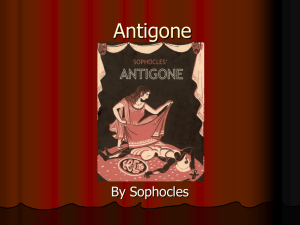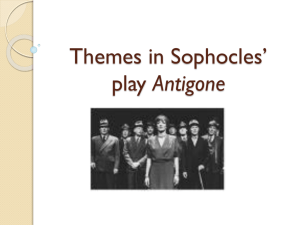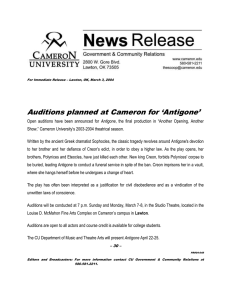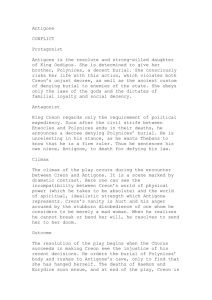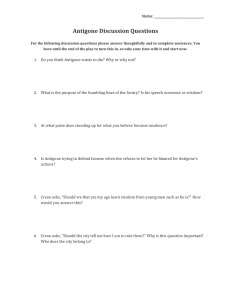Photograph ("Finland 2" by Spencer Tunick, 2002) removed due to...
advertisement
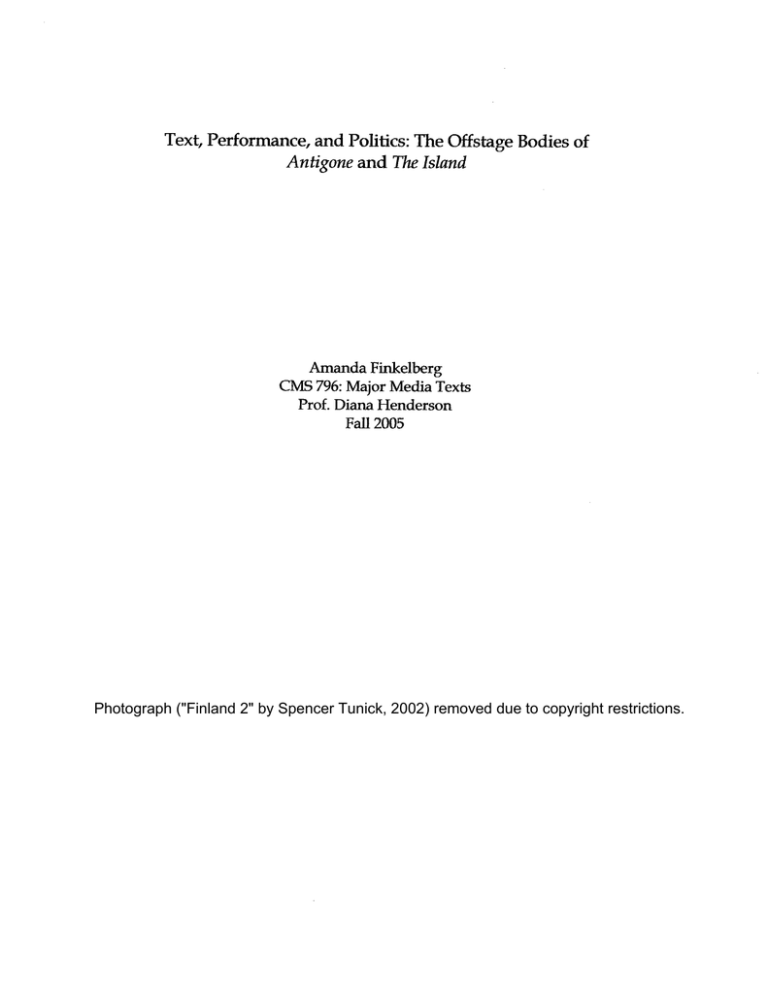
Photograph ("Finland 2" by Spencer Tunick, 2002) removed due to copyright restrictions. The link between theater and politics may be obfuscated by the understanding that one is real and the other is mimesis. Perhaps this is w makes theater such an effective medium for communicating dissent organization helps to elucidate its absurdities and injustices in a setting 6 hi.- S " w+qc that is almost real. The political function is reasonably clear for actors who spe but may not be as clear when the character is not written into the play as an bbwq' embodied character but as an offstage presence that &ects the actors in vario ~ ~ y v:A ;dd7 ~~h~ manners. A I functions in three distinct ways1 I or figurative .@e; directly in the text, either as a character with a spoken part or a character defined - \\ \ * $7by the other characters. This body is rich with authorial intent, it is the body IS"' "/* C "\d"#' created by the playwright to convey meaning. Secondly there is the performance body through which the character is activated, filtered, and adapted. Although a /reader can imagine the performing bodyLgination can not embody the c$' +/,bjective identity in the way a real This embodiment produces a relationship between performance and audience that is distinct from the C,lL2 r bodies in the written play and in our imaginations. Finally there is an ideological r w A '"'. > d* \ body, the political body. This body exists within both textual and performance F bodies and is the outgrowth of body theory, omp&ed of its individual G- subjective la\The political body, as I am choosing to call it, is the sigruficance of certain qualities of identity (e-g.race, gender, etc.) within its social context. It is c5 this body that gives Ganing to both the textual and the performance body. R These three categories provide a framework for examining onstage and offstage bodies. It may be useful here to clarrfy what is meant by "body theory". Early philosophic explorations into the body as a concept introduced questions of veracity. Is the corporeal body real and how can we know that? Descartes is credited with initiating the mind-body split, when "I think therefore I am" c v w W W' 2 kita&' became the credence for understanding the relationship between corporeal and + E. ' ~ d : * /- 7 cognitive. Descartes posited that he was a brain in a.-jar imagining the body of a , 1 r557 . . / - man.This crucial turn literally sublimated the body as a social receptor; if it is eLAAd-3 Iv ~ j not even really there, how can it be a valuable consideration for social theory? In their introduction to "The Body: A ReaderJ' M. Fraser and M. Greco quote ' . 'G Thomas Osborne's claim that disregarding the body in entirety is as "misguided" A as disregarding cognition. He provides a valuable framework for what body study may produce: [not] a representation of what the body is (of providing a theory of the body, or of asserting its irreducibility) but [to log] the ways in which the body is a problem; and a problem in the positive sense- not just as an 'obstacle', but as a vehicle for thought and action.1 Current social construction theories do not view the body as a biological given but as constituted in the intersection of discourse, social institutions, and Fraser, Mariam and Monica Greco. The Bodv: A Reader. London and New York: Routledge 2005 P- 3 "7 the corporeality of the body.2 Also termed subjectivity, this view de-centers the individual in the Cartesian sense (that identity and being are mutually interdependent) and reframes "human nature with concepts of history, society and culture as determining factors which determine individual identity and destabilize the coherence of that identity by making it an eflect rather than simply an origin of linguistic practice."3 Social analysis has expanded from studying the body as an object of social control and discipline "in order to legitimate different regimes of domination" 4 to perceiving it as a subject that creates meaning and performs social action.5 The body has become a necessary critical layer in gender and ethnicity studies because although we may all be merely brains in jars, some of us have -1 ce/ . imagined more empowered bodies for ourselves than others. And if we are !c\\ corporeal and real, the body is a necessary filter for everything the brain experiences; the two can not be separated or conveniently reduced. Therefore, examining the body in text may uncover a substantial layer of subtext and meaning. How an author chooses to create bodies from words is often more explicit than the words themselves. In the cases of Antigone and The Island, the invisible Sasson-Levy, Orna and Tamar Rappoport. "Body, Gender, and Knowledge in Protest Israeli ~overnents~h e case". Gender and Society Vol. 17, No. 3. June2003 p. 381 3 %id. 381 Foucault, Michel. Discipline & Punish:The Birth of the Prison. New York: Vintage, 1995. pp. 7580 Sasson-Levy, Orna and Tamar Rappoport. "Body, Gender, and Knowledge in Protest Movements:The Israeli case". Gender and Society Vol. 17, No. 3. June2003 p. 381 bodies and offstage characters (Polynices in Antigone and Hodoshe in The Island) function as complex political symbols of power and powerlessness. In that they are both created for a performance medium, theater, an additional physical layer J is added as the characters are literally embodied or markedly not embodied. A reader reading a written version of a play must create "bodies" from the text to act out the parts in her imagination. A viewer in the audience at a performance of the same play may think of the bodies she is seeing as "characters" and thus experience the bifurcation of textual body from performance body. This separation becomes more sigruficantwhen the material 7 involves torture or pain because layer is removed in the process of embodying that may allow a viewer a voyeuristic, pleasurable sensation in lieu of (or simultaneous to) a feeling of disgust or revulsion. The &di%7 politicized body I\, (!Y\~~%A n ctions in complex ways; it not simply corporeality, a "docile body", yet is it not liberated from the means of corporal control. Both of wKfidm,qM-+? -I x L. these aspects figure into the tension that compr&<sthe A 2 prisoner- p f l initial dissent that brings about incarceration and the process of retaining or 'b'e / be qJ,~%eiinquishingthat dissent beyond torture. It is the aim of this essay to explore \PI this tension between textual and performance body of Antigone and The Island examining the body's relationship to torture and subjugation in each text and conside&& relationship. embodiment through performance may or may not affect tlus \" The story of Antigone, a young girl who defies the law of her uncle, Creon, to bury her fallen rebel brother Polyniceswas not new when Sophocles Y appropriated it in 5th century B.C. Greece. The story came out of an oral tradition that was by 441 B.C. already a familiar medium to the hundreds of thousands of theater goers now regaled by costumes, masks, and dramatic performance. In his introduction to the play, Bernard Knox explains that while the stories were "preserved and created images of universal signrficance... [they] also had the authority of religion; these stories are the sacred tales of religious cult and recall (or rather create) a time when men and gods were closer than they have been ever since." 6 The origmal relationship of these myths to Gods and religious life is sigruficantas it frames theater in 7 interesting analytic questions about how these Sophocles' play unburied on the battlefield, just outside the city of Thebes. To remain unburied and unrnourned is the greatest of all possible degradations to an ancient Greek. Unburied bodies can not make the voyage to the afterlife. While Polynices is not visibly onstage in this play, the presence of his rotting of Antigone and her sister Ismene's argument over what to do about the burial. Antigone cries, "He's to be left unwept, unburied, a lovely treasure for birds that 6 Sophocles, Robert Fagels, Bernard Knox. Oedipus at Colonus. New York: Penguin Classics 1982 p. 23 scan the field and feast to their heart's content."7 The image of the fallen warrior I eaten by birds invokes Polynice a degraded body punished by law. Hegel found the power distribution between Antigone and Creon not a tension between right and wrong but a tragic conflict of two equal sides, each possessing some good; "a collision between the two highest moral powers."s Evidence for the claim that Sophocles found Creon sympathetic was drawn from his opening speech. Creon asserts that it is his duty to protect the city, "Zeus as my witness...I could never stand by silent, watching destruction march against our city."9 Here righteous leader who is acting on behalf of the gods to protect his degenerates into sadistic and vindictive language as he calls for Polynices to be "left unburied, his corpse carrion for the birds and dogs to tear, an obscenity for the citizens to behold."lo It does seem that this is the P& point where Sophocles ceases to even1 distribute sympath .Creon appears to be acting not as a benevolent or punish. He declares: "Never at my hands will the traitor be honored above the Polynices' body is further degraded as the Sentry explains that it has been sprinkled with dust and given proper rights but "not a sign in sight that dogs or p. 60 Ibid. p. 23 9Ibid. p. 68 ' 0 Ibid. p. 68 Ibid. p. 68 7 Ibid. 8 " would beasts had worried the body, even tom the skin."* This line does not seem to have a narrative function other than to illicit the vulnerability of a dead exposed body, to underscore the humiliation bestowed upon Polynices for the audience and recall Creon's declaration that this is exactly what should happen to the enemy's body. T Although not visible onstage, Polynic dy provides two discrete lends the motivation his sister Antigone needs to actively defy it establishes the tone and shape of the State by giving Creon a reason to declare a law, establish his authority as a lawmaker, and have d something to enforce. In Discipline Gz Punish, Michel Foucault explores the history of the modern prison not only technique" that in part A defines the State by ensuring that thei-e will always be an opposing tension, an enemy of State, to urufy against, punish, and control. "The correlative of penal justice may well be the offender, but the correlative of the penitentiary apparatus is someone other; this is the delinquent, a biographical unity, a kernel of danger representing a type of anomaly."l3 Recall Creon's categories "traitor" and "patriot". By establishing Polynices as a traitor, Creon has drawn a boundary for e State. This distinction is at the root of State power and human organization /J" could not function withoufan-)mderstanding of what is collective good and what 12 Ibid. p. 73 Foucault,Michel. Jkcipline & Punish: The Birth of the Prison.New York: Vintage Books, 1995 l3 P, a% , ,\\"l: "'; / J The fallen and debased body of Polynices sets in action the events that will ultimately complete the tragic end to three people and undermine the authority of the State. It is this invisible body that primarily motivates the choices of all of the other characters and ultimately actors. The Island by Athol Fugard, John Kani and Winston Ntshona opens with a scene of physical torture. Two prisoners perform the futile and exhausting task of digging a hole in the beach; as one digs, the other fills. When they are exhausted, they are then forced to run while tied together and simultaneously beaten brutally. The scene has no dialogue and is written in the text as a stage direction. The two prisoners, John and Winston, enact torture that is being inflicted upon them yet there are no other actors onstage. Like Polynices in Antigone, it is an unseen body in this play that sets the narrative in motion. / The body of Hodoshe, the prison warden in this scene, remains unseen throughout The Island and is shaped only by the words of John and Winston. The first spoken word of the play is Winston calling "Hodoshe!" a meaningless sound for anyone unfamiliar with the Afrikaans language (the majority of the f> play's ori@ w audience was foreign). A reader may look up the word's meaning, discover the relationship to carrion flies which feed on the dead, and surnrnarilY / 8 make the connection to e Creon's desire that Polynices' flesh be eaten by carrion. In this way, Hodoshe becomes not only the violent, invisible, warden of the State but also the parasite that sustains itself on its ward. This connection is J made on a textual level but must also translate elegantly to the stage. One can imagine how the scene of two men being beaten by an invisible force would visibly invoke the confines of oppression. Marla Carlson suggests that "by] rendering the warden and the guards invisible, The Island depersonalizes the entire South African social system and 2' focuses id the effects of oppression on the bodies of the two pris0ners.'4~' Perhaps I it would be impossible for one actor to embody the complexity of the South African apartheid system or the human cruelty necessary to violently beat political prisoners. Hodoshe is missing from the stage, in body, but he is present , in all of the empty space around the men we see. (ti' L Carlson continues, "Aristotle pbmted out, theater represents pain in order to create pleasure; and secondly, it "tends to establish [a] (false) complicity between the victimizer and the victim" because the actor who plays the victim "is actually onstage by choice; the real victim is not"J5 The separation of the physical body of the actor from the physical body of the character he or she is embodying enables viewers to experience violent and troubling acts at a safe distance. This distance is amplified when we consider the effect that skill and celebrity have on the performing body. Carlson finds The Island "foreground(s) the actor's skill and athletic exertion in representing the victim's pain [so] the spectator is likely to respond not only to the martyr but also to the actor, who is Marla Carlson, "Antigone's Bodies: Performing Torhue". Modern Drama Vol. 46, No. 3. Fall, 2003 p. 390 15 Ibid. p. 382 l4 empowered by his or her creative contribution to the theatrical event." l6 The process of embodying pain or torture inherently removes it several degrees from its unthinkable reality. On one hand this exposes audiences to situations and feelings they might not otherwise experience. On the pfher are the yarning signs d i" of the numbing effect Susan Sontag cautioned against "the risk of making the audience passive, reinforcing witless stereotypes, confirming distance and creating fascination" 17. nfi$l 64 I believe the form& override4 the later, that "performing torture" can have 4 a greater effect than reading about torture. Clearly a theatrical mimesis will not YtJl b s possess the intensity of the torture itself but more rntensity than the text alone, A because it is embodied. If, as Carlson suggests, the actor's body offers a distance from the torture, surely the reader's imagination must offer a similar protection rendering it an almost moot point. Unless it is the godto likral&beat a message . into our audience, we may be content with a degree of removal. However, I do find that complex political messages performed into a void do tend to evoke a sense of complacent satisfaction, as Carlson also indicates. A 1986 audience could experience The Island, feel bad and go back home feeling satisfied that they had for a moment truly understood the violence and absurdity of apartheid but not be moved to do anything. Perhaps a progressive solution that addresses Sontag's valid concern but still utilizes the evocative nature of theatre would p. 384 Ibid. p. 382 16 Ibid. l7 // integrate some form of action into the performance. I am thinking of the "What can I do now?" handout that accompanied Michael Moore's "Fahrenheit 9-11'' which gave emotionally charged audiences concrete suggestions for how to enact change. Without this kind of inclusion, protest theater runs the risk of minimizing both the problem and the solution; rendering what could be a deeply disturbing issue as superficial pith- )'$-I,$ f I /Mdhf Body theory provides an interesting filter through which theater is both complicated and clarified. By examining only two of the bodies of these complex 9GILLdh, dl& plays, we can begin to see how much meaning is embedded in the body's ' ULJ)m4 construction, how it affects characters and situations and how it is performed (or - rnk not performed). A deeper understanding of this construct can only improve the way we think about performing bodies and their relationship to politics. &&J,@-ji Aqf-m,&& body and performance and their relationship to some class materials. I have not mentioned the converse, and equally interesting, relationship of protest as the work I've dedicated to subjdvity and body theory in this paper will be & /, - Bibliography: & Punish: The Birth of the Prison. 2nd ed. New Foucault, Michel. Discipline Ysrk: Vintage Books, 1995. Anderson, Patrick. "To Lie Down to Death for Days: The Turkish hunger strike, 2000-2003" Cultural Studies Vol, 18, No, 6 November 2004, gg, 815-846 Carlson, Marla. "Antigone's Bodies: Performing Torture". Modern Drama Vol. 46, No. 3. Fall, 2003 pp. 381-403 Durbach, Errol. "Sophocles In South Africa: Athol Fugard's The Island". Comparative Drama Vol, 18, No. 3. Fall, 1984 pp. 252-254 Fugard, Athol, John Kani, Winston Ntshona. Statements. New York: Theater Communications Group, Inc. 1986 Fraser, Mariam and Monica Greco. The Body: A Reader. London and New York: Routledge 2095 Sasson-Levy, Oma and Tamar Rappoport. "Body, Gender, and Knowledge in Protest Movements: The Israeli case". Gender and Ssciety Vol. 17, No. 3. June 2003 pp. 379-403 Sophocles, Robert Fagels, Bernard Knox. The Three Theban Plays: Antigone, Oedipus the Kina Oedipus at Colonus. New York: Penguin Classics 1982
